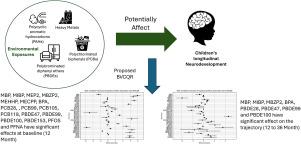评估环境化学混合物对儿童神经发育的纵向影响:贝叶斯方法
IF 2.7
引用次数: 0
摘要
本文提出了一种新的贝叶斯变系数分位数回归(BVCQR)模型,旨在评估化学接触混合物对儿童神经发育的纵向影响。认识到环境暴露的复杂性和高维性,提出的方法通过提供一种可以管理数据稀疏性并提供可解释结果的方法来解决现有研究中的关键空白。提出的BVCQR模型估计了特定年龄的混合对神经发育结果的影响,利用马蹄形先验进行稀疏性,并利用贝叶斯方法进行不确定性量化。我们的仿真证明了该模型在处理高维数据方面的鲁棒性和有效性,与传统模型相比有了显著的改进。该模型在环境健康结果和措施研究(HOME)中的应用进一步说明了它在确定影响儿童生长和发育的重大化学品接触方面的效用。研究结果强调了BVCQR在环境卫生研究中的潜力,为分析复杂化学混合物的纵向影响提供了一个复杂的工具,对旨在了解和减轻环境对儿童健康的风险的未来研究具有启示意义。本文章由计算机程序翻译,如有差异,请以英文原文为准。

Assessing the longitudinal impact of environmental chemical mixtures on children’s neurodevelopment: A Bayesian approach
This manuscript presents a novel Bayesian varying coefficient quantile regression (BVCQR) model designed to assess the longitudinal effects of chemical exposure mixtures on children’s neurodevelopment. Recognizing the complexity and high-dimensionality of environmental exposures, the proposed approach addresses critical gaps in existing research by offering a method that can manage the sparsity of data and provide interpretable results. The proposed BVCQR model estimates the effects of mixtures on neurodevelopmental outcomes at specific ages, leveraging a horseshoe prior for sparsity and utilizing a Bayesian method for uncertainty quantification. Our simulations demonstrate the model’s robustness and effectiveness in handling high-dimensional data, offering significant improvements over traditional models. The model’s application to the Health Outcomes and Measures of the Environment (HOME) Study further illustrates its utility in identifying significant chemical exposures affecting children’s growth and development. The findings underscore the potential of BVCQR in environmental health research, providing a sophisticated tool for analyzing the longitudinal impact of complex chemical mixtures, with implications for future studies aimed at understanding and mitigating environmental risks to child health.
求助全文
通过发布文献求助,成功后即可免费获取论文全文。
去求助
来源期刊

Hygiene and environmental health advances
Environmental Science (General)
CiteScore
1.10
自引率
0.00%
发文量
0
审稿时长
38 days
 求助内容:
求助内容: 应助结果提醒方式:
应助结果提醒方式:


